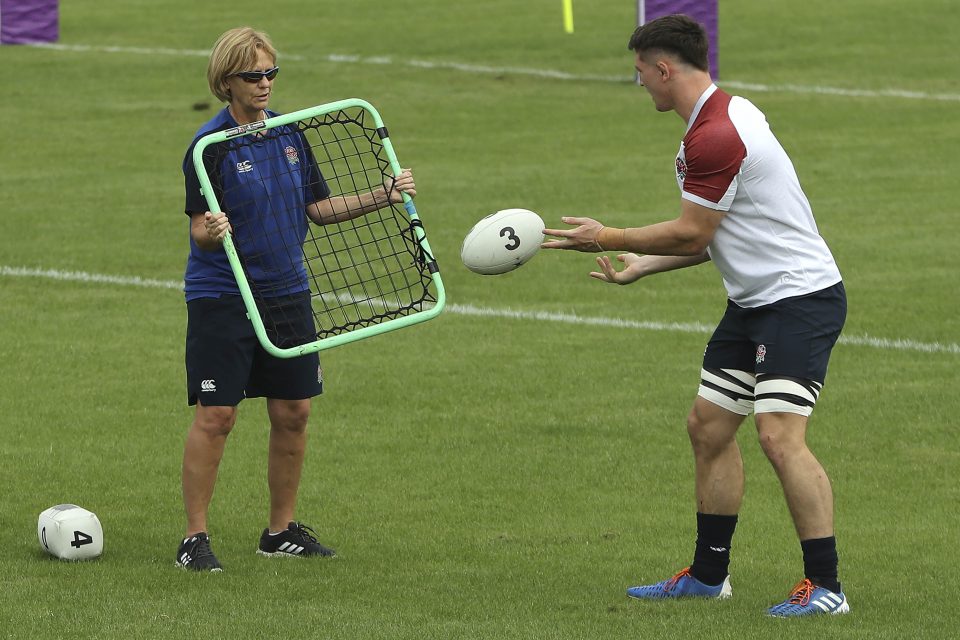The SA coach with eyes in the back of her head
Sherylle Calder is sought after around the world as an expert who teaches sports teams and individual athletes to ‘see’ better, improving their speed, decisions, actions – and results.
Author:
30 April 2021

To walk into the offices of the EyeGym in Stellenbosch in the Western Cape is to enter one of the great rooms of sporting memorabilia in South Africa. Rugby jerseys, football shirts, balls, caps and all manner of paraphernalia are splashed across the walls, each item carefully inscribed with a note of sincere gratitude.
Sports scientist and performance coach Sherylle Calder has built an international career over the past two decades thanks to her unique methods, which quite literally open the eyes of some of the world’s top athletes to new horizons. Though she admits to finding it difficult to explain what she does, Calder is renowned as an expert who gives athletes, schoolchildren and even everyday vehicle drivers the tools to perform at their best.
She has best been described as a vision coach, and the anecdotes behind that vision are startling. “I don’t really take the time to reflect on the journey thus far because there has always been a new challenge to face up to,” Calder says.
Related article:
But there has been a lot more time to ponder all sorts of things during the global Covid-19 pandemic, because everyone’s movements have been severely limited. “So much of our work is international, across sporting codes, so the travel issues have really hit our business,” she says.
Calder has won two Rugby World Cups – with England in 2003 and South Africa in 2007 – and was again on the England staff for the 2019 edition in Japan, which they coincidentally lost to the Springboks. “Working and winning the 2003 World Cup with England was an incredible journey. There were some of the biggest personalities in English rugby – massive guys like Martin Johnson and Lawrence Dallaglio. Then little me.”
But England all bought into the process, especially coach Clive Woodward, who was convinced that Calder would provide the edge that the team needed. “Sherylle has impacted on players’ skills performance, improving passing, catching, kicking accuracy, tackling, concentration and, ultimately, better decision-making,” Woodward said in the aftermath of the successful 2003 campaign.
Instilling confidence
The hero of that 2003 World Cup, Jonny Wilkinson, who kicked the winning drop goal with his weaker foot to beat Australia in extra time, gave Calder an even better endorsement. Upon returning to England with the Webb Ellis Cup, the squad had an audience with Queen Elizabeth. After the reception, Calder was being chauffeured in the same car as Wilkinson. As they weaved their way through London back to the team’s hotel, she turned to the biggest star in the game and asked him what he thought working together had done for him.
“He said that as a flyhalf he knew that he had three choices as the ball was being passed to him in open play: run, pass or kick,” she says. “He had to make that decision as the ball got into his hands. By the time we finished working together, he explained, he already knew which of those three choices were the best one for the situation in front of his eyes. I found that feedback from one of the greatest ever players under pressure extremely rewarding.”
Calder has worked for the Pakistan and Australian national men’s cricket teams, Surrey County Cricket Club, the All Blacks, Australian Football League’s West Coast Eagles team, American National Football League’s Miami Dolphins, the Canadian ice hockey team Vancouver Canucks, the Dutch and British Olympic teams as well as Monaco FC and Bournemouth, to name some of her clients over the years.

“It wasn’t always easy in the beginning being a woman going into largely male spaces,” she admits. “But the work speaks for you and the respect from the different teams has been something I’ve grown to really appreciate. I remember going to the All Blacks and all these massive athletes coming up and being so humble and respectful in my space.”
She also remembers her first engagement with Pakistan and how quickly they also grew to respect her work. “Stepping into different cultures, you have to be aware of how they understand women’s roles. There is an initial process to work through and it’s got a lot better over the years.”
Clear goals
Calder has designed programmes that sharpen athletes’ visual performance, and some of her results have been truly astonishing. She is firm about setting timeframes and targets for progress because of her own faith in these programmes.
“I truly believe that we can take any athlete and make them truly great if they put in the hard work,” she says. “I am always open to working with different sporting codes and not just dwelling with one. I played hockey when I was young, and my coach told me that I played as if I had eyes at the back of my head. That’s when I realised I had this gift and then made it my life’s work to share it and help others.”
She admits that she finds it hard to watch sport purely as a form of mindless entertainment and is always calculating how any athlete can be taken to a higher level. “Just before the travel lockdown, I had been working with a really diverse portfolio of people,” she says.
These included Formula One racing driver Valterri Bottas; a British fencing prospect who had just qualified for the Tokyo Olympics; and a squash player from India. She was also working with the ecofriendly Forest Green Rovers, who are chasing promotion to the English Football League Championship. “I spent an amazing week with the club in the Cotswolds and we did some great work. I just find their approach and their commitment to being environmentally conscious very inspiring.”
Related article:
Calder has tracked Forest Green Rovers in their quest for promotion and would have loved to be closer to them in the final few weeks of the 2020-2021 season. As she goes through her client list, the common denominator is the travel required to make it all work.
“I need to actually see my clients to really get the best out of them. Online simulations are a compromise, but the business had really suffered during this unprecedented period,” she reflects.
“We have been very lucky to be able to still do some work online, including keynote speaking and our online programmes, which people can use independently. So many other businesses have had to shut down completely, so we consider ourselves to be very fortunate.”
Calling on ‘that crazy woman’
Perhaps one of her most successful South African stories is the work she did with Ernie Els when the golf legend was at a particularly low ebb. Els has always been one of golf’s greatest ball strikers, with a languid swing motion propelled by enormous levers. Add an imaginative short game, and it was no surprise that Els was the closest thing to a proper rival that Tiger Woods had during his prime time around the turn of the century.
But Els gradually developed a nervous tension with his putting, the most crucial component of elite golf. There was one particularly painful example of his struggles on the green. At the Scottish Open, Els hit a towering long iron from 240 yards away, with the ball settling no more than four feet from the flag and leaving him the chance for an eagle. But he nervously stabbed at the ball twice, missing both attempts before tapping in for a deflating par. He looked to the heavens, dropped his shoulders and trudged to the next tee box.

Enter Calder, upon the invitation of businessman Johann Rupert. They met on the practice green at Fancourt in early 2012. Within a few minutes of Els doing Calder’s exercises, he saw enough light at the end of the tunnel to formalise a working relationship. She told Els that, as long as he trusted her process, he would win again within six months of working with her.
“It was tough and these things take time. To build the trust up with someone you’ve just met, when you’ve known your way for a long time, is a process. We basically redesigned his putting stroke and all credit has to go to him,” says Calder, who ended up travelling with the golfer around the world.
The culmination of that work was Els snatching the 2012 Open Championship in Lancashire, England, with an incredible run of putts in his final stretch of holes. In his winner’s speech, Els noted the amount of work he had done with this “crazy woman called Sherylle”.
As pleasing as such standout achievements are to Calder, she says more work should be done in athletes’ formative years to open their eyes to their true potential. “I just love the reaction of people when they see progress in our work. I can’t wait to get back to some sort of normal so we can work closer with athletes embarking on all these wonderful journeys through sport,” she says.
Indeed, there is still space on her office walls for yet more framed sporting memories.


